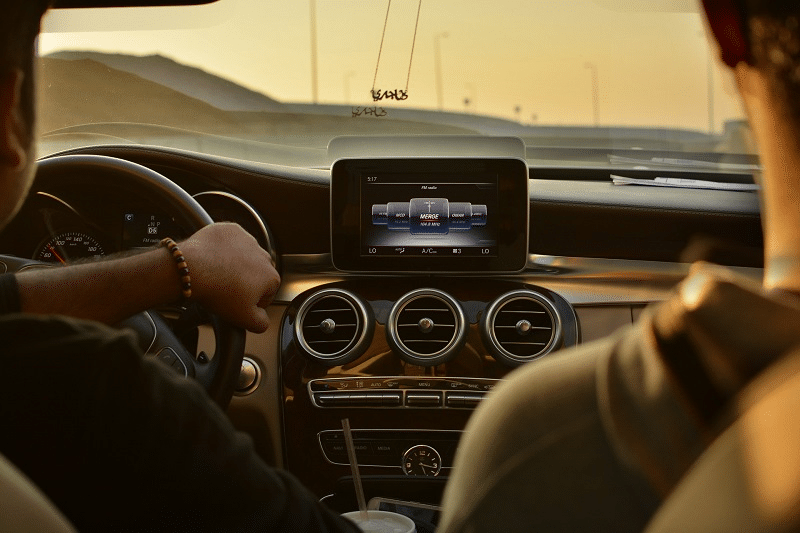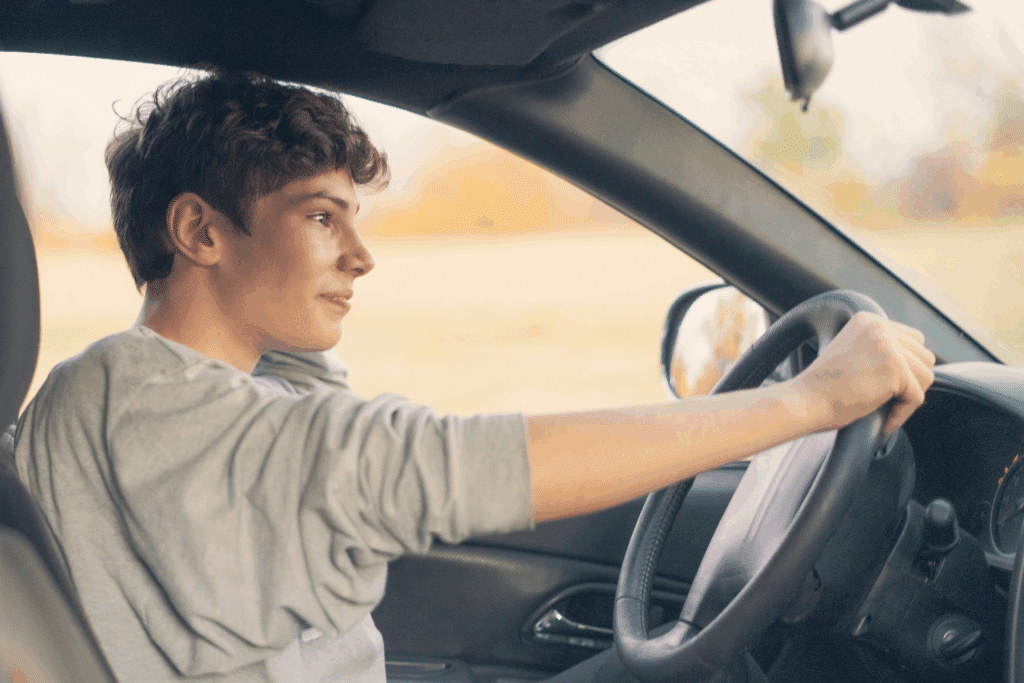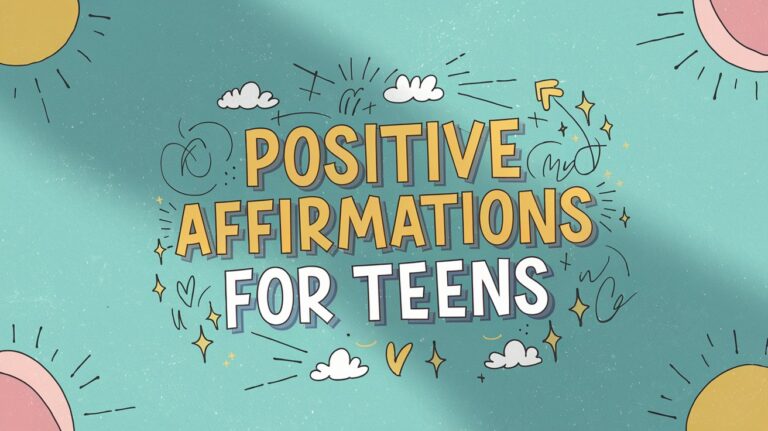California law restricts 16-year-olds from driving passengers under 20 during the first 12 months unless a qualified adult is present or a valid exception is documented. The GDL program enforces these limits through a phased licensing system designed to lower crash risks linked to peer distractions.
Violating these rules leads to fines, license penalties, and higher insurance rates, with repeated offenses risking full license revocation. Parental guidance, consistent boundaries, and the use of monitoring tools like teen GPS trackers help teens stay safe and legally compliant.
What Are the Passenger Restrictions for a 16-Year-Old in California?
A 16-year-old holding a provisional license in California faces a clear legal boundary when it comes to driving peers. Transporting passengers under 20 is only allowed if a qualified adult is present in the vehicle.
That qualified adult must be either a licensed parent or guardian, or a California driver who is at least 25 years old. This rule ensures that a responsible adult can supervise and step in if any driving risk arises.
The law applies equally to all teen drivers, no matter how responsible they appear to be. Even high-achieving or cautious teens cannot drive friends under 20 during the first year without supervision.
Can a 16-Year-Old Drive With Passengers in California?
No, a 16-year-old in California cannot drive with passengers under age 20 for the first 12 months after receiving their license, unless specific conditions are met.
This rule belongs to California’s Graduated Driver Licensing (GDL) program, which prioritizes public safety and adolescent driving skills.
What is the Graduated Driver Licensing (GDL) Program in California?
The Graduated Driver Licensing (GDL) program in California limits teen drivers’ exposure to high-risk situations. It applies to drivers under 18 and introduces driving privileges in stages.
These stages form the core of teen driving laws in California, aiming to reduce crash risks during a teen’s first years behind the wheel.
Instruction Permit
At age 15½, teens can apply for a learner’s permit. They must finish driver education and pass a written test.
Provisional License
At age 16, teens can qualify for a provisional license. They must complete 50 hours of supervised driving, including 10 at night, and hold the permit for 6 months.
Full License
At age 18, or after 12 safe months with a provisional license, teens get a full license. No violations during the provisional phase are required.
When Can a 16-Year-Old Drive with Passengers Under 20?

A 16-year-old in California is not allowed to drive passengers under 20 under normal conditions. However, the law allows exceptions when the situation calls for it and the teen carries written proof.
Medical Necessity
If someone needs to be driven due to a medical issue, a signed note from a doctor must explain the illness and why the teen is responsible for transportation. This applies only when no other reasonable option is available.
School-Related Activities
When driving is tied to a school function like a practice, meeting, or event, a school official such as a coach or principal can confirm the need in writing. This must clearly state the reason and the time frame involved.
Employment Duties
If the teen’s job involves transporting someone under 20, the employer can explain the work-related requirement in writing. The note should confirm that it’s part of the teen’s job responsibilities.
Family Emergencies or Needs
In urgent family situations, a parent or guardian can provide a signed explanation. It should outline the reason the teen must drive and when it’s necessary.
Law enforcement requires this documentation to be in the vehicle at all times during such trips. Digital files or verbal explanations are not considered valid under California law.
What Happens if a 16-Year-Old Breaks the Passenger Rule in California?
Breaking the passenger restriction comes with serious consequences. California enforces these rules to reduce risks for teen drivers and others on the road.
Traffic Citations and DMV Points
First-time violations usually result in a $50 traffic ticket. In addition, the DMV assigns one point to the teen’s driving record.
License Restrictions and Suspensions
A second offense brings a 30-day restriction on the teen’s license. After three or more violations, the DMV can suspend the license for six months.
Higher Insurance Rates
Points and suspensions signal risk to insurance providers. As a result, premiums often rise significantly for both the teen and their family.
Further Penalties and Revocation
Repeated violations may lead to DMV hearings and mandatory traffic school. In some cases, the state can revoke a provisional license before the driver turns 18.
Why Does California Ban 16-Year-Olds from Driving with Passengers?
California restricts 16-year-olds from carrying passengers to reduce deadly crashes caused by distractions. Driving with peers raises the chances of poor decisions, like speeding or ignoring traffic signals.
Crash data shows fatal accidents are 2.5 times more likely when teens drive with friends instead of driving alone. By keeping the focus on the road during the first year, the law lowers crash risk and protects new drivers.
When Can a 16-Year-Old Drive Siblings in California?
A 16-year-old cannot drive siblings under 20 unless supervised by an adult or carrying valid written documentation. Living in the same house or going to the same school does not qualify as an automatic exception.
To make it legal, a parent or guardian must write and sign a note that explains the specific need. A school-related or medical reason must be clearly stated in the documentation.
What Happens After 12 Months of Provisional Licensing?
After a clean 12-month record with no violations, a 16-year-old can drive passengers under 20 without supervision. The restriction on driving between 11 PM and 5 AM is also lifted.
These expanded privileges still require full compliance with all traffic laws. When the driver turns 18, the provisional status automatically ends and converts to a standard Class C license.
Does the Law Apply to All California Counties Equally?
Yes, California’s vehicle code applies across every county without exception. Local governments cannot change or remove any part of the state’s teen driving laws.
Schools and workplaces might ask for different formats of written proof, but those minor differences do not change the legal requirement. The rule to carry valid documentation remains the same everywhere.
Can Parents Be Fined if Their 16-Year-Old Violates the Passenger Rule?
Parents are indirectly impacted when a teen breaks license rules and gets into an accident. They can face legal and financial consequences if someone is injured or property is damaged.
Liability claims, rising insurance costs, and civil lawsuits are all possible outcomes. California’s Parental Responsibility Law holds guardians accountable for letting minors drive without supervision.
Is California the Strictest State for Teen Driver Laws?
California ranks among the five strictest states for teen driver safety. High traffic volume and crash rates in cities justify its firm GDL rules.
Other states with strong teen driving restrictions include New Jersey, Massachusetts, and Oregon. Each of these states uses a tiered license system and enforces night curfews for new drivers.
How to Keep Your Teen Driver Safe?
Keeping your teen safe on the road starts with setting clear expectations and staying involved in their driving habits. Parents play the biggest role in shaping how teens handle responsibility behind the wheel.
Set Driving Boundaries Early
Talk to your teen before they start driving about the rules they must follow. Limit nighttime driving and enforce passenger restrictions even beyond what the law requires.
Practice Together Regularly
Spend time in the car coaching your teen in different driving conditions. Driving in rain, at night, and in traffic builds real-world experience they won’t get in lessons alone.
Monitor Driving Behavior
Use tools like a teen GPS tracker to monitor speed, location, and sudden braking. Reviewing this data regularly helps spot risky behavior early and correct it before it leads to real danger.
Model Safe Driving Yourself
Teens mirror their parents behind the wheel. Always wear a seatbelt, avoid texting, and obey traffic laws so they learn by example.
Keep Communication Open
Let your teen know they can call you if they feel unsafe or unsure. Having a backup plan reduces pressure to take risks just to avoid getting in trouble.
Creating a safe driving foundation begins with your guidance and continues through trust, consistency, and good habits.
Conclusion
A 16-year-old in California must follow strict passenger rules for the first 12 months after receiving a provisional license. These laws reduce distractions, lower crash risks, and are enforced equally across the state.
Understanding the GDL program and following every requirement helps teens stay compliant and avoid penalties. With support from parents and clear driving habits, young drivers build safe routines from the start.


















